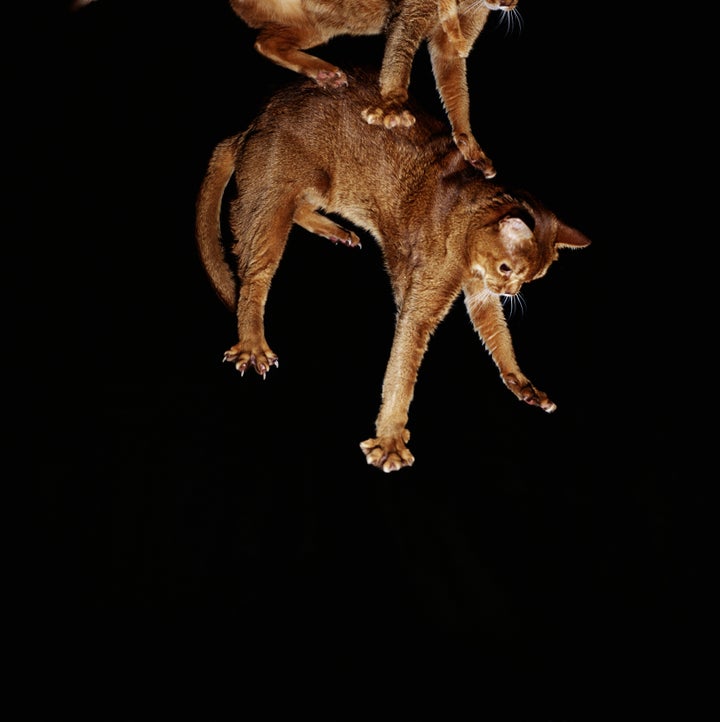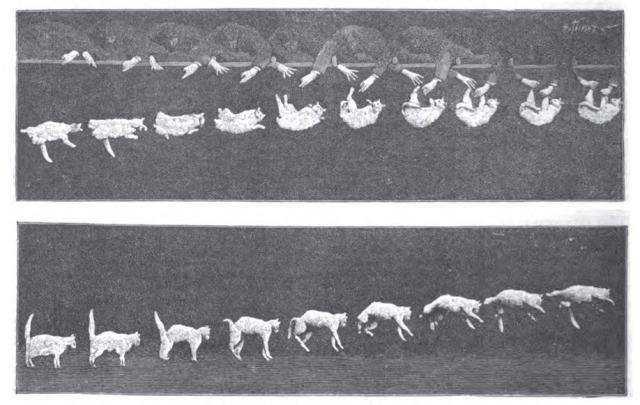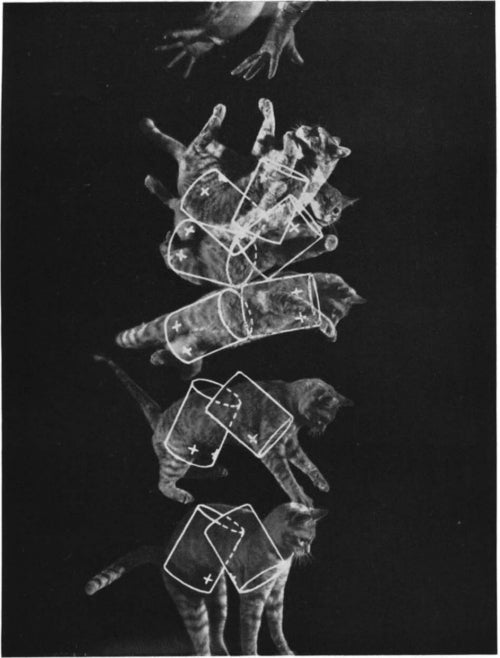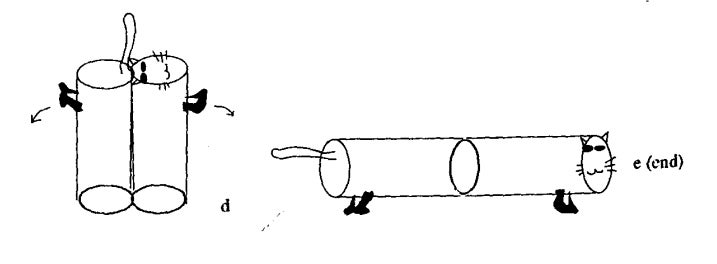
GK HartVikki Hart/Getty Images
How do cats flip in mid-air without violating the conservation of angular momentum? originally appeared on Quora: the place to gain and share knowledge, empowering people to learn from others and better understand the world.
Answer by Paul Mainwood, Degrees in Physics and Philosophy, Doctorate in Philosophy of Physics, on Quora:
In the 19th Century, great physicists like James Clerk Maxwell and George Gabriel Stokes labored to put in place the physical principles and mathematics required to lay the foundations for classical field theories. But when it came time to relax, they did what any red-blooded Victorian gentleman would do: they threw cats out of the window.
Here’s Maxwell explaining this activity to his wife (who had presumably heard stories and needed some reassurance that he wasn’t entirely mad):
There is a tradition in Trinity that when I was here I discovered a method of throwing a cat so as not to light on its feet, and that I used to throw cats out of windows. I had to explain that the proper object of research was to find how quick the cat would turn round, and that the proper method was to let the cat drop on a table or bed from about two inches, and that even then the cat lights on her feet.
(The Life of James Clerk Maxwell with extracts from his Correspondence, letter, 1870 p.599)
Stokes’ daughter also wrote about it, though she made it sound rather less pleasant for the cat:
He was much interested, as also was Prof. Clerk Maxwell about the same time, in cat-turning, a word invented to describe the way in which a cat manages to fall upon her feet if you hold her by the four feet and drop her, back downwards, close to the floor. The cat’s eyes were made use of, too, for examination by the ophthalmoscope, as well as those of my dog Pearl: but Pearl’s interest never equalled that of Professor Clerk Maxwell’s dog, who seemed positively to enjoy having his eyes examined by his master.
(Memoir and Scientific Correspondence of the Late Sir George Gabriel Stokes, Humphrey, 1907)
Stokes and Maxwell were intrigued by the same question as above: how does the cat manage to turn around without violating the conservation of angular momentum? The prevailing assumption in the 19th century was that the cat must be using some kind of “push off” from the dropper’s hand.
However, pioneering high speed photography from Étienne-Jules Marey (1894) showed that this was not so: there is no initial rotation from a dropped cat (the photo sequence goes from top right to bottom left):

(Nature, 1894)
Marey’s photographs showed what was happening, but didn’t give much insight into how the physics worked. Several remarkably influential papers over the course of the 20th century went progressively deeper into the phenomenon:
- L. Lecornu, 1894: Suggested (basically correctly) how the rotation was possible given a non-rigid cat body.
- G. G. J. Rademaker and J. W. G. ter Braak 1935: Advanced on Lecornu’s solution with a simple two cylinder model that they matched qualitatively to photographs.
- T.R. Kane and M. P. Scher, 1969: Gave a more detailed analysis and added computer analysis to overlay solutions on some beautiful photographs (see below).
- R. Montgomery, 1993, Gave more general solutions, showing that Kane and Scher’s solution is the most efficient, and nailed down some surprising links to gauge theories in physics.

The physics is really very intricate. The basic answer that Lecornu described and then Radenaker, Braak, Kane and Scher filled out, is that the cat keeps its total angular momentum at zero at all times by bending its body sharply, and then twisting the each half on two axes that combine to cancel out the rotation of the whole.
However, while this motion is straightforward enough to set up in differential equations, it is almost impossible to explain in words. One of the better non-technical ways of “getting it” is Wikipedia’s animated gif, but even clearer (in my mind) is Montgomery's hand-drawn cartoon.
The reason Montgomery’s approach is so clear is that he chooses to examine an “extremified” twisting path that separates several stages of motion and shows them in isolation. This gives clarity at the expense of a realism — a common trade-off in physics. (Also, his cat appears to be wearing sunglasses, but this is not essential either).
- First stage: Folding up — (Zero angular momentum because both parts are moving in opposite directions.)

- Second stage: Rotate each half in opposite directions — (Zero angular momentum because you have two equal halves rotating opposite to one another.)

- Third stage: Unfold — (Zero angular momentum for the same reason as the first stage.)

(To repeat, this process is an extremised example which serves shows that rotation is possible while maintaining zero total angular momentum. It is not something a real cat could do: its back would break. A real cat combines the stages into one another, which circumvents the need for a full 180 degrees fold.)
But if this isn’t confusing enough, Montgomery’s paper then ups the ante further by showing that the cat’s twisting has a deep connection to gauge theory.
To do this, Montgomery reformulates the problem in terms of a “space” of shapes that the cat can adopt, relates this to the overall configuration space for the cat, and imposes a condition that constrains the total angular momentum to zero. He then shows that the reachable states give him a gauge situation (with the anholonomy being the overall rotation of the cat in physical space) and then — apparently for fun — shows that the optimized solution for reaching any given orientation is equivalent to the equations of motion for a charged particle travelling on the projective plane under the influence of an axially symmetric magnetic field and metric.
Which is all quite a surprise. But it brings us back — via quite a diversion — to Maxwell and Stokes’ day jobs: for gauge theories built on their field theoretic foundations formed the basis of some the most successful and influential theoretic work of twentieth century physics.
This question originally appeared on Quora - the place to gain and share knowledge, empowering people to learn from others and better understand the world. You can follow Quora on Twitter, Facebook, and Google+. More questions:
